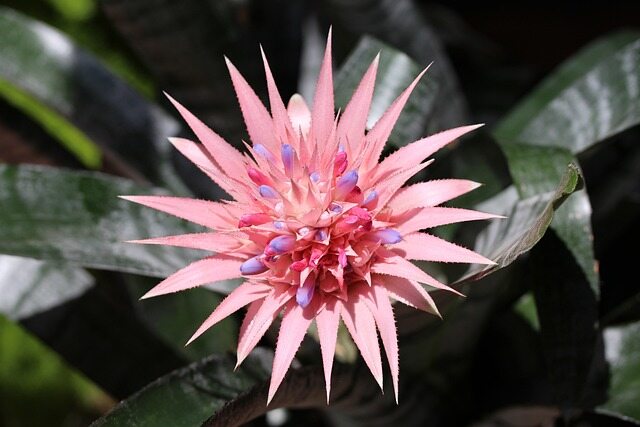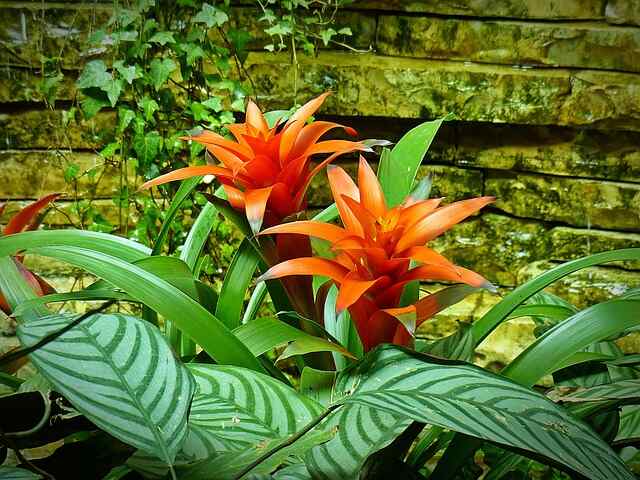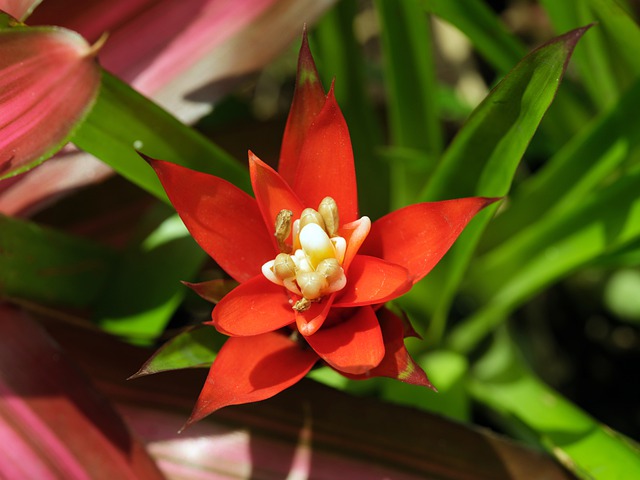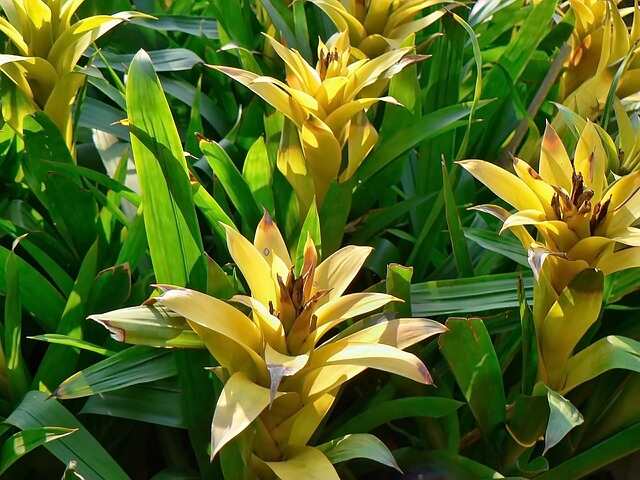You may have tried a beautiful Swiss cheese plant, pothos, and other aloe vera plant in your garden. But now you must try a new and more exotic house plant that can enhance the beauty of your indoor attire.
Bromeliads, a beautiful houseplant that have become more and more popular in the last few years for being so unusual, with attractive foliage and interesting shaded bracts, a sort of modified leaf.
Do you want to learn more? Do you want the growing and caring guide of Bromeliad plant?
Then you are at the right place. So let’s visit our blog to learn more.
Plant overview
Bromeliad are one of the popular members of the Bromeliaceae plant family typically having striking, sword-shaped leaves and a bright, unusual-looking bloom, which is a bract surrounding an insignificant flower in real.
Bromeliad hail from tropical rainforests, where they can grow naturally on the bark of trees, rather than in the ground.
The roots of this plants are used to grip on to their host, and they acquire moisture from a central ‘vase’ or ‘tank’ in the middle of the rosette of leaves that fills with water whenever it rains. In the wild regions, frogs may also sometimes raise their young in these tanks.
Once bromeliad flower have bloomed, they die back after some times, so they’re not long-lived house plants to grow.
They produce new plants at the base of the plant. however, these base can be potted up and grown on.Bromeliads are very easy to take care for so are a good choice for beginners.
Types of Bromeliads to grow
Although bromeliad is usually grown in a blended potting mix, most of the species of these plants are epiphytic plants when found in their native range generally in the tropical and subtropical regions of the Americas.
Some of the common species of bromeliads used as houseplants include:
Guzmania
The genus Guzmania includes most of the most common and readily available species of bromeliad that includes G. lingulata, G. zahnii, G. Guzmania sanguinea, and G. monostachia.
These vatiety of plants have long, flat, glossy green leaves and a bract which is bright red but depending on different species, there are some that are yellow, orange, purple, or pink. The blooms of these species are very long-lasting, holding up at least for two to four months.
Neoregelia
Neoregelia is the most diverse species of all the bromeliad genera. These species are used as houseplants especially for their most colorful bracts, ranging from pink to deep purple.
These species form short, fairly flat rosettes of leaves in the plant. some miniature rosettes are no more than 1 inch across while some other plants can be as much as 40 inches wide.
Vriesea
Virsea is one of the bromeliad species in the Vriesea genus. It features with tropical, feather-like blooms and variegated foliage. Some of the popular varieties are V. splendens and the hybrid Vreisea.
Ananas comosus Champaca
Ananas is one of the popular species of bromeliad which includes the common pineapple variety, and the cultivar of one species. In fact, ‘Champaca’, is an ornamental pineapple variety which is often grown as a houseplant. This bromeliad species features with spidery leaves and miniature pineapples on top of the flower spike.
How to care for bromeliad?
Here is everything you want to know about the caring guide of bromeliad.
Light
Bromeliad requires bright, filtered light in order to thrive. Looking at their requirements, place your plant in an east, south or west-facing window as north-facing don’t get enough light.
But don’t let your plant grow in the hot sun or they may burn. If you are growing your plant indoors and you don’t have enough natural light, an LED grow light may also work.
Also, stay patient! Plants may require 18 to 30 months to grow before flowering, though you can often buy your plant with the bloom already intact.
Soil
When grown indoor, Bromeliads thrive in well-draining potting soil that holds moisture for a longer period but drains well.
A mixture of two-thirds of peat-based soil and one-third sand is often ideal for growing bromeliad. You can also use orchid mix, charcoal, or soilless potting mix for you plant.
Most of the bromeliads are generally epiphytic that can be grown in containers, or you can also try to grow your plant as authentic “air plants” that are mounted to boards or logs which is typically secured with ties or glue.
Water
Bromeliad bear leaves that form water-holding cups, also named as urns, so they can store rainwater for further use when they grow in their natural environments.
If you want to water your plant, add a few tablespoons of water to the cup of your bromeliad, near the base of the plant, and fill it occasionally. It’s okay if water is overflowing into the growing medium, but don’t let your planting medium get soggy.
Alternatively, you can also water your plant at soil level, but water your plant only when the soil feels dry out when you stick a finger way into the soil.
Or else you can also use a moisture meter to check the level at root depth and only water your plant when it reads dry. While planting, make sure that your pot has holes in the bottom that dump out excess water in the saucer.
When it comes to water use, you should only use rainwater, distilled water, or softened tap water which you should let sit out for a day or two to allow some of the chemicals to dissipate before use.
Temperature and humidity
When it comes to humidity requirements, the Bromeliad plant needs to be put in a room that has a relative humidity of 40 to 60%.
So if you are living in a place with less humidity, it is suggested that you mist it often, place your plant near a humidifier, or use a pebble tray. Along with that, avoid placing your plant near air conditioning vents, doors, and drafty areas, as well.
Also, your Bromeliad plant prefers to grow in temperatures between 70–75°F during the day and between 60–65°F at night.
Fertilizer
Although bermilad don’t require fertilizer to grow on, adding some fertilizer may enhance their growth.
So feed your plant once a month during the growing season from April to September. You can also use a foliar type fertilizer, which you can spray directly on the leaves, or a balanced houseplant food at half-strength.
How to propagate your bromeliad?
An unusual characteristic of this exotic houseplant or bromeliad is that their central rosette will often die after flowering.
After this happens, your plant will produce several babies at its base. These baby plants can be used to propagate bromeliad.
It can be left in the original pot, and they also can be divided into more plants for further use. While dividing bromeliads, make sure to wait until the babies are at least 10-15cm long.
Lift the mother bromeliad plant out of its pot to remove the individual baby plants. While propagating be careful not to damage any roots attached to the new plants.
Pot each of the baby plants in a peat-free, house plant compost to propagate, then water both the compost and the rosette.
Rooting may take around a month. Alternatively, you can also wait until the main plant begins to die off, then cut it out and leave your babies to grow where they are. The new plant may take upto several years to flower again.
Conclusion
Bromeliad is a beautiful houseplant which showcase with beautiful bracts and attractive foliage. So bring this beauty to your home and enhance the attire of your garden.
You may also like to read
How to grow and care for Pineapple Lily plant – A step-by-step guide
How to Grow Pineapples? See the Tropical Fruit Growing at Your Home!











